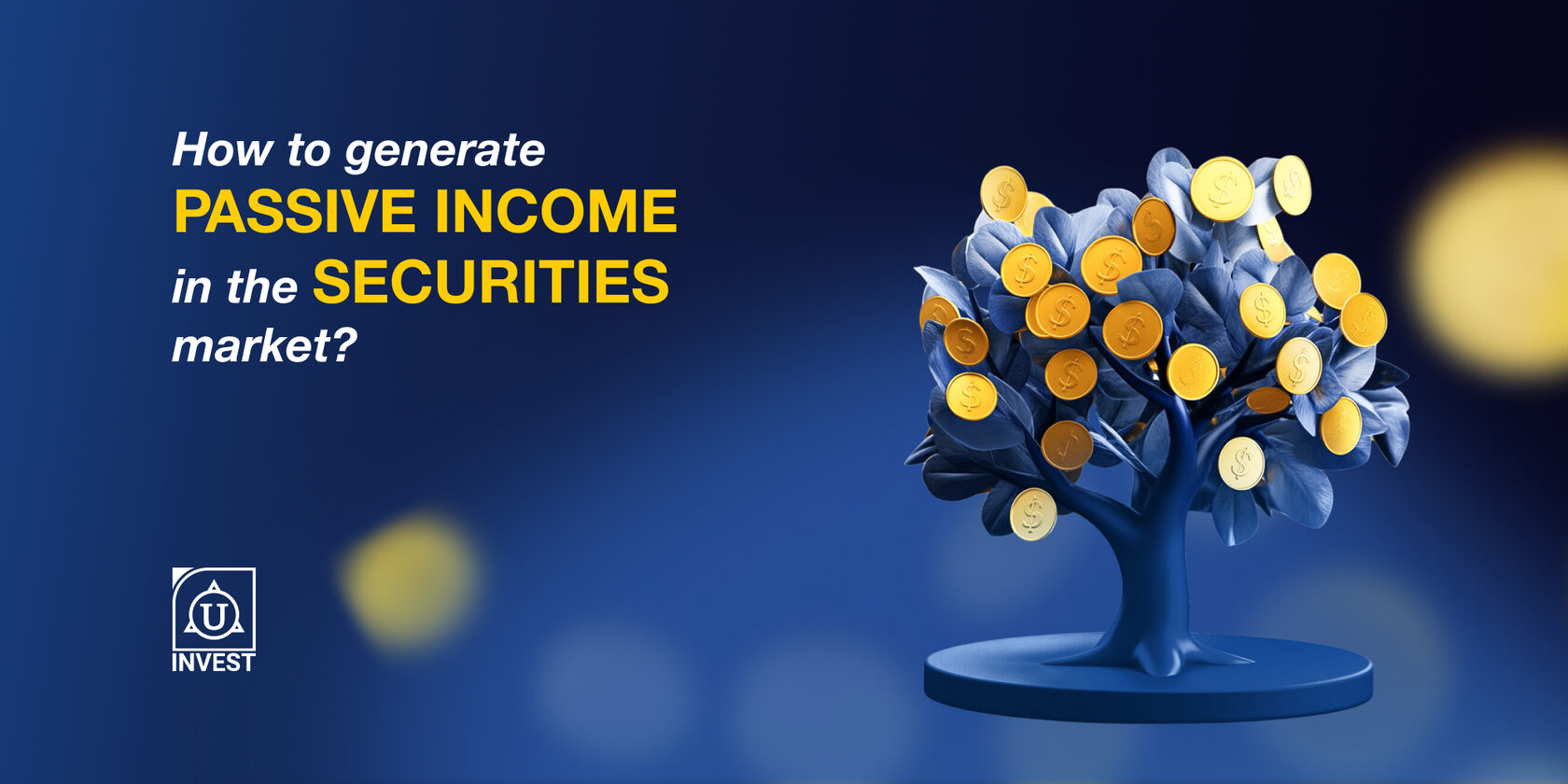In today's world, when financial independence and stability are a priority, and especially when the idea of earning passive income seems more attractive to many investors than ever before, how can one resist? After all, you can earn money from your investments without additional effort, even while you're sleeping. One of the most effective ways to earn passive income is through the securities market, which includes stocks, bonds, ETFs, and other financial instruments.
In a previous blog, we talked about active and passive investments, and how they're different. This time we present 5 options on how to generate passive income in the securities market and what strategies to use to ensure a stable income.
In a previous blog, we talked about active and passive investments, and how they're different. This time we present 5 options on how to generate passive income in the securities market and what strategies to use to ensure a stable income.

1. DIVIDEND STOCKS
Dividend stocks are shares of companies that pay part of their profits to shareholders in the form of dividends, either every three months or once a year. To earn a passive income from dividends, you need to invest in companies that reliably and consistently pay dividends. These are usually large, well-established companies with a steady income and a commitment to sharing profits with shareholders. When you invest in these companies, you can earn a steady income without selling your shares.
To ensure stable income, choose stocks with a low payout ratio (where a large portion of the profits is not paid out as dividends).
Consider a Dividend Reinvestment Plan (DRIP), which automatically reinvests your dividends into more shares, increasing your income over time.
To ensure stable income, choose stocks with a low payout ratio (where a large portion of the profits is not paid out as dividends).
Consider a Dividend Reinvestment Plan (DRIP), which automatically reinvests your dividends into more shares, increasing your income over time.
2. BONDS AND BOND FUNDS
Bonds are financial instruments issued by governments, corporations, banks, or other organizations. When you buy a bond, you are lending money to the issuer in exchange for regular interest payments (coupons) until the bond matures. The interest payments from bonds are a form of passive income. If you invest in government or corporate bonds, you typically receive stable interest payments during the bond's term. After that term, you'll get your original investment back.
If you want to invest in bonds, you can buy a bond ETF or mutual fund. These options are good if you want to invest in a variety of bonds and not worry about managing them yourself.
Be aware of interest rates, as rising rates can reduce the value of existing bonds.
If you want to invest in bonds, you can buy a bond ETF or mutual fund. These options are good if you want to invest in a variety of bonds and not worry about managing them yourself.
Be aware of interest rates, as rising rates can reduce the value of existing bonds.

3. EXCHANGE-TRADED FUNDS (ETFS) AND INDEX FUNDS
ETFs and index funds are investment vehicles that pool money from multiple investors to buy a diversified basket of assets, such as stocks or bonds. These funds are designed to track specific market indexes (e.g., the S&P 500) or sectors.
Many ETFs and index funds, especially those focused on dividend-paying stocks or income-generating bonds, provide dividends. By investing in these funds, you can earn income from the dividends they distribute, as well as benefit from the long-term growth of the market.
To increase passive income, look for dividend-based ETFs or income-focused index funds.
Choose funds with low expense ratios, as high fees can reduce your profits.
For stable income, invest in broad-market index funds that are diversified across several sectors and stocks.
Many ETFs and index funds, especially those focused on dividend-paying stocks or income-generating bonds, provide dividends. By investing in these funds, you can earn income from the dividends they distribute, as well as benefit from the long-term growth of the market.
To increase passive income, look for dividend-based ETFs or income-focused index funds.
Choose funds with low expense ratios, as high fees can reduce your profits.
For stable income, invest in broad-market index funds that are diversified across several sectors and stocks.
4. MUTUAL FUNDS
Mutual funds are a way for investors to put their money into a bunch of different stocks, bonds, or other assets. Income-focused mutual funds usually invest in stocks or bonds that pay dividends to make regular payments.
Like ETFs, mutual funds can pay out money through dividends or interest payments. Income-focused funds may pay out money every month, quarter, or year, depending on how the fund is set up.
Invest in mutual funds that focus on assets that generate income, such as high-yield bonds or stocks that pay dividends.
Make sure the fund has a solid track record of performance and consistent payouts.
Be mindful of management fees, as these can reduce the amount of income you receive.
Like ETFs, mutual funds can pay out money through dividends or interest payments. Income-focused funds may pay out money every month, quarter, or year, depending on how the fund is set up.
Invest in mutual funds that focus on assets that generate income, such as high-yield bonds or stocks that pay dividends.
Make sure the fund has a solid track record of performance and consistent payouts.
Be mindful of management fees, as these can reduce the amount of income you receive.
5. REAL ESTATE INVESTMENT TUSTS (REITS)
A real estate investment trust (REIT) is a company that owns, operates, or finances real estate projects. REITs let investors put their money into large-scale real estate projects, like shopping malls, office buildings, or apartment complexes, without needing to own property directly.
REITs must give at least 90% of their taxable income as dividends to shareholders, which makes them an attractive option for passive income because you can benefit from both real estate income (in the form of rent) and capital appreciation.
Publicly traded REITs are easy to buy and sell because they are traded on stock exchanges.
Choose equity REITs, which own properties, over mortgage REITs, which invest in real estate loans, for more reliable income.
Look for REITs with a high dividend yield for a consistent cash flow.
REITs must give at least 90% of their taxable income as dividends to shareholders, which makes them an attractive option for passive income because you can benefit from both real estate income (in the form of rent) and capital appreciation.
Publicly traded REITs are easy to buy and sell because they are traded on stock exchanges.
Choose equity REITs, which own properties, over mortgage REITs, which invest in real estate loans, for more reliable income.
Look for REITs with a high dividend yield for a consistent cash flow.

CONCLUSION
Generating passive income through the securities market is a great way to build wealth over time. There are many options, including dividend stocks, bonds, and ETFs and mutual funds.
But before you invest, do your research and talk to a financial advisor to make sure your investments are right for you. With the right strategy and patience, you can create a reliable passive income stream in the securities market.
But before you invest, do your research and talk to a financial advisor to make sure your investments are right for you. With the right strategy and patience, you can create a reliable passive income stream in the securities market.
HOW TO INVEST?
Open a free brokerage account with Unibank Invest and start investing. The Unibank Invest app provides access to the world’s largest stock exchanges, enabling you to purchase international investment instruments, such as stocks, bonds, and ETFs.
To open a brokerage account, fill out the online application or call +374 43 004 382.
To open a brokerage account, fill out the online application or call +374 43 004 382.
